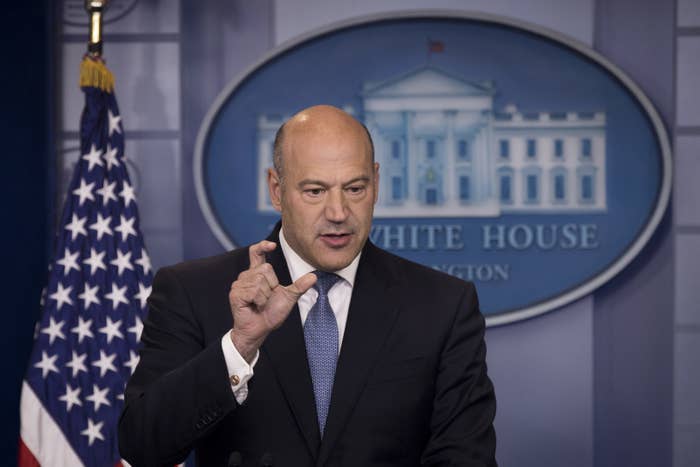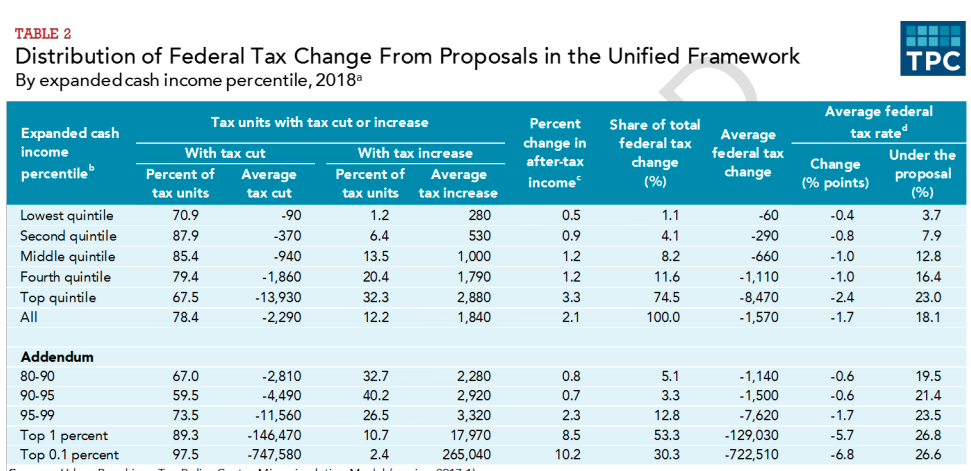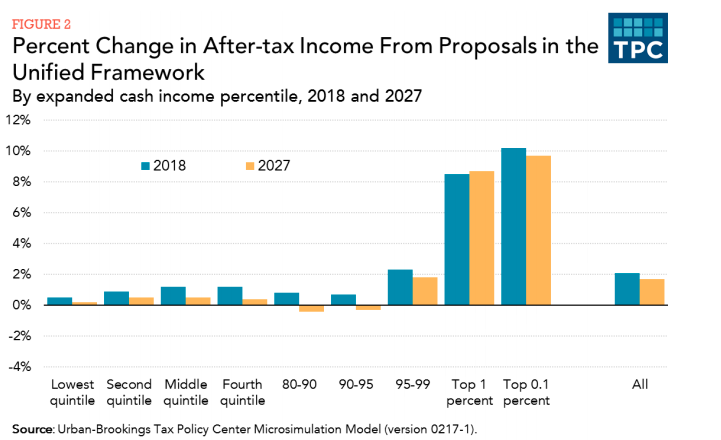
The White House tax proposal would cut taxes for most Americans, with the rich enjoying the biggest benefits, while a large group of taxpayers — mostly those with high wages who live in high-tax states — would see tax increases, according to the Urban-Brookings Tax Policy Center's analysis of the plan.
While the White House has been eager to emphasize the broad range of people who would get tax cuts under the plan, they have admitted that not everyone would. While National Economic Director Gary Cohn told ABC News the tax plan was “purely aimed at middle-class families,” he did say that whether or not your taxes went down or up "depends on which state you live in."
A number of the plan's provisions seem to target a very specific group of taxpayers. The plan eliminates the deduction for state and local taxes, which is particularly concentrated in a few high-income, high-tax — and liberal — states like California, New York, New Jersey, and Illinois.
Almost one-fifth of the $516 billion of state and local taxes that were deducted in 2014 came from California, with $68.4 billion coming from New York, $30.6 billion from New Jersey, and $25.5 billion from Illinois, according to data from the Tax Policy Center. Texas, which is large but low tax, had only $20.3 billion in state or local taxes deducted. In California, the average deduction claimed was just over $17,000, and in New York it was $21,000.
The plan to get rid of the deduction has already drawn complaints from some congressional Republicans, especially those who represent high-tax states. New Jersey Republican Tom MacArthur told Politico that he would "fight this out and hopefully have success in getting this restored."
Even Orrin Hatch, the Utah Republican chair of the Senate Finance Committee said he would prefer to keep the deduction. Martin Sullivan, the chief economist for the tax publication Tax Analysts, described the plan to get rid of the deduction as a "good way for the GOP to f*#k blue-state Republicans."
Repeal the state and local tax deduction? That's a good way for the GOP to f*#k blue-state Republicans.
Overall, the TPC found, about 12% of taxpayers would pay higher taxes in 2018, including more than a third of taxpayers with incomes between $150,000 and $300,000. While various taxpayers across the income spectrum would pay higher taxes, there would be cuts for 89% of those in the top 1% — and over 97% of the top 0.1%.
Overall, 78% of taxpayers would get a cut, with an average size of $2,290. For those in the top 1%, the average cut would be $147,000, while those in the top 0.1% would get cuts averaging $748,000.
People with low incomes would mostly see tax cuts, although the cuts would be smaller both in dollar terms and as a percent of their total incomes.

While the White House and Congress hasn't specified where the new tax brackets would be, the TPC used the tax brackets from a previous Congressional Republican plan. The framework also did not specify how the child tax credit would change, but using the older plan the TPC assumed it would move from $1,000 to $1,500.
The harvesting of tax revenue from some affluent taxpayers is partially how the plan avoids blowing a bigger hole in the federal government's budget. The repeal of the state and local tax deduction and scrapping the personal exemption would generate almost $1.9 trillion in revenue between 2018 and 2027, making it by far the biggest revenue increasing provision in the tax outline. Without it, the plan would be far more costly.
And over time, more and more of these people would face higher taxes, the TPC analysis found. That's because the real value of the child tax credit would shrink, since it's not indexed to inflation, and the levels that the higher tax income rates kick in would grow more slowly than they do now. So as incomes rise over time, more and more people would pay higher rates on some of that income. By 2027, 60% of taxpayers with incomes between $150,000 and $300,000 would pay higher taxes, and a quarter of all taxpayers face a tax hike, the TPC analysis found.
Overall, the TPC said that over 10 years federal revenue would drop by $2.4 trillion, without making any allowances for increased economic growth from the changes in tax policy. In a speech today, President Trump described the plan as “rocket fuel for our economy.” Treasury Secretary Steven Mnuchin even claimed that the plan would decrease deficits by $1 trillion.
The proposal drops the corporate tax rate to 20% from 35%, allows businesses to more completely deduct the cost of their investments from their taxable income for five years, and overhauls the system to only tax corporate income domestically while imposing a special one-time tax on corporate cash that's currently overseas. The corporate tax provisions, the TPC estimates, would cost $2.6 trillion over 10 years.
The reduction in corporate taxes would also be another big win for the rich, who are most likely to own stocks.

Administration officials, up to and including the president, have insisted that the plan would not benefit people like the president. They have suggested that they could impose a new top individual rate, but that has not been specified in the plan. The New York Times estimated that, based on President Trump's 2004 tax return, he would save more than $1 billion, mostly through getting rid of the estate tax.
Several provisions of the tax outline would massively and narrowly benefit the very wealthy. The plan would repeal the Alternative Minimum Tax, which would affect almost two-thirds of taxpayers with incomes between $500,000 and $1 million in 2017, according to the TPC. The estate tax would be scrapped, despite only applying to estates valued over $5.49 million.
The TPC estimates that in 2017, under the current law, only "11,310 individuals dying in 2017 will leave estates large enough to require filing an estate tax return," and of those, only "5,460 estates will owe tax," with two-thirds of those paying sitting in the top 10% of the income distribution.
And so-called "pass through" businesses — which are partnerships or companies run by their owners whose income is reported on personal tax returns as opposed to corporate ones — would see their top rate drop to 25% from 39.6%. The TPC says about half of all this income is earned by the top 1%.
There's also concern that the wealthy will seek to turn what's really wage income into "business" income to pay the lower rate, although the White House and Republican legislators said they would write rules to prevent this. High earners could also try to rearrange their employment so that they become individual contractors as opposed to employees.
"It's hard to have those provisions in a tax proposal and not benefit high-income people disproportionally," said Mark Mazur, the director of the TPC and a former senior Treasury Department official.
